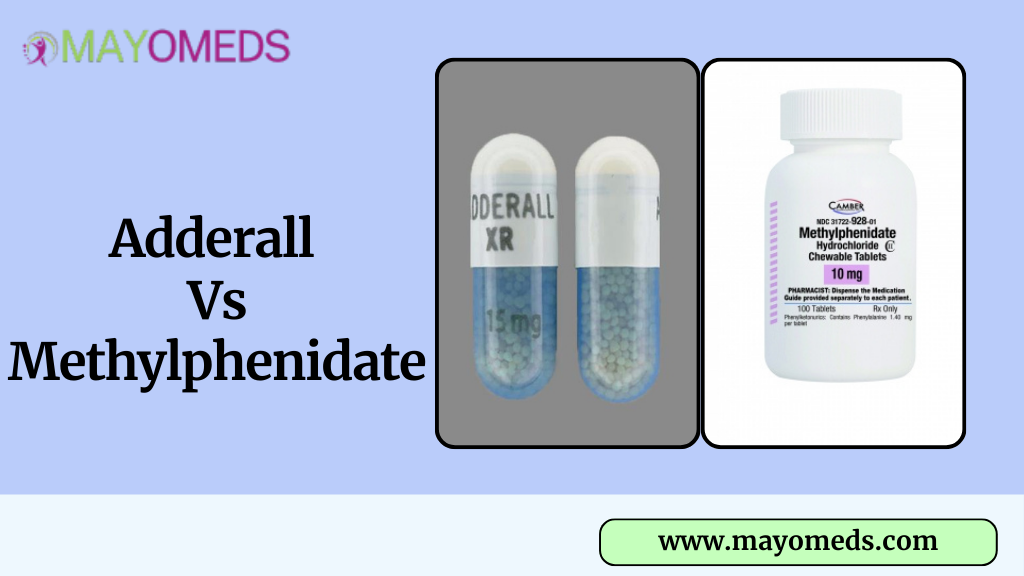Adderall and Methylphenidate are the two major prescribed medications in the treatment of ADHD (Attention-deficit/Hyperactivity Disorder) and narcolepsy. Both Medications are central nervous System Stimulants. Both medications are recommended for people age above 6 years who are diagnosed and Identified with symptoms of ADHD but have different chemical compositions, dosages, action times, and effectiveness. In this article (Adderall vs. Methylphenidate), we will further discuss its Other aspects!
The Key Difference Between Adderall and Methylphenidate
The primary difference between methylphenidate and Adderall depends on their exact modes of action and, thus, their chemical makeup. Both have same effects through rather different mechanisms, despite being central anxious system stimulants that are typically used to treat ADHD.
Chemical Sum-Up:
The combo medication Adderall is made up of four distinct amphetamine salts:
- Saccharate dextroamphetamine -25%
- Sulfate of dextroamphetamine -25%
- Aspartate of amphetamine -25%
- 25% amphetamine sulfate
As a result, the mixture includes two different forms of amphetamine, also called as enantiomers: levoamphetamine and dextroamphetamine. Most people agree that dextroamphetamine is the stronger central anxious structure stimulant.
Methylphenidate: The active component of this drug is methylphenidate hydrochloride. Although it shares molecular similarities with benzylpiperazine and phenethylamine, it is not an amphetamine.
Action Mechanism
Although the basic effect of both medications is to raise dopamine and norepinephrine levels in the brain, their exact mechanisms of action differ slightly.
- Methylphenidate: It is thought to work primarily as a dopamine and norepinephrine reuptake inhibitor. This results in a greater concentration and longer-lasting action of these substances by blocking the transporters that typically remove these neurotransmitters from the synapse, or the area between nerve cells. According to some data, it might also have mild agonist activity at the serotonin 1A receptor, which would raise dopamine levels even further.
- Adderall: It works by enhancing dopamine and norepinephrine release while also blocking ingestion. These neurotransmitters can be released from their storage vesicles into the synapse by the amphetamine components entering the presynaptic neuron. Like methylphenidate, it also prevents dopamine and norepinephrine from being reabsorbed. This dual action is often considered to make Adderall generally more effective.
Start and Length of Action:
- Methylphenidate: Immediate-release formulations leads to have a quicker result of action and reach peak levels in the blood sooner (around 1-2 hours) but have a shorter duration of effect (3-4 hours). Extended-release formulations are designed to last longer (6-12 hours or more).
- Adderall: Immediate-release formulations also work relatively quickly (within 30-45 minutes), with peak levels reached slightly later than methylphenidate (around 3 hours), and they incline to have a longer duration of effect (4-6 hours). Extended-release versions (Adderall XR) can last for 8-12 hours or longer.
Effectiveness: Adderall Vs Methylphenidate:
The effectiveness of Adderall and Methylphenidate for treatment of ADHD is most researched Topic.
Overall Efficacy:
- Both work well: Both Adderall and methylphenidate, the main component of Ritalin, are stimulant drugs that effectively treat ADHD symptoms in both adults and children, according to numerous studies. They improved focus, attention, and impulse control by raising dopamine and norepinephrine levels in the brain.
- Comparable rates of response: Generally speaking, between 70 and 80 percent of people with ADHD react favorably to stimulant drugs. About half of this group might react similarly to methylphenidate or Adderall.
- Individual variability: It is important to realize that each medication’s effectiveness might differ greatly from person to person. The finest option for one person could not be the best one for another. A number of variables come into play, including metabolism, individual brain chemistry, and particular symptom patterns.
Potential Differences in Efficacy:
- In certain areas, Adderall might have a little edge: According to certain research and meta-analyses, Adderall may have a little but statistically significant edge over standard-release methylphenidate, especially when it comes to physicians’ and parents’ overall assessments of improvement.
- Extended duration of effect: In comparison to immediate-release methylphenidate, Adderall typically has a longer half-life and duration of activity. This may improve compliance and lessen the requirement for in-school dosing by allowing for symptom control throughout the day with fewer doses.
- Potency: According to some study, Adderall may have more potency than methylphenidate, which means that a smaller dosage of Adderall may provide effects that are comparable to those of a higher dose of methylphenidate. According to one study, Adderall is roughly twice as effective as methylphenidate.
- Efficacy over time: Unlike shorter-acting methylphenidate formulations, Adderall may continue to be effective later in the day because of its extended duration of action.

